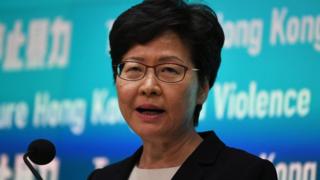Hong Kong bans face masks after months of protests
Leader Carrie Lam said authorities could not “just leave the situation to get worse and worse”. …

 Image copyright AFP
Image copyright AFP Hong Kong’s chief executive Carrie Lam has used a colonial-era emergency law to ban face masks after months of angry protests.
The measure was announced on Friday, after the city saw widespread violence on 1 October, the 70th anniversary of Communist Party rule in China.
Ms Lam said the violence was “destroying the city” and authorities could not “just leave the situation to get worse and worse.”
The ban comes into effect on Saturday.
The legislation invoked by Ms Lam, called the Emergency Regulations Ordinance, dates to 1922 and has not been used since there were riots in Hong Kong in 1967.
Hong Kong’s protests started in June, sparked by proposals to extradite suspected criminals to mainland China.
The extradition bill has since been cancelled but protests have widened into broad pro-democracy demonstrations.
Over the months, clashes between police and activists have become increasingly violent. On Tuesday, police shot a protester with a live bullet for the first time.
Authorities said the 18-year-old, who was arrested after being shot, was in a stable condition in hospital.
Where does the ban apply?
Secretary for Security John Lee said the ban would apply for approved and unapproved public assemblies – rallies and marches – as well as in unlawful assemblies and riots.
There are exemptions for people wearing masks for health reasons, or if required by their profession.
Ms Lam stressed the new regulation did not mean that Hong Kong was in a state of emergency. But she said the city was “in a state of serious public danger”.
Hong Kong is a former British colony handed back to China in 1997.
It has a “one country, two systems” agreement that guarantees it some autonomy, and its people certain freedoms.




